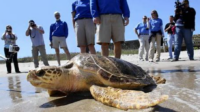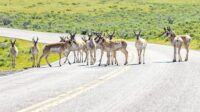Wildlife Conservation Funding – Endangered charismatic species can be found everywhere in advertisements, billboards and logos. The fund allows brands to give back through biodiversity. Will they pay?
We are pleased to make these articles freely available under the terms of the Creative Commons Attribution-NonCommercial-ShareAlike 3.0 Unported License. At the beginning of the post, provide the author, source and link to the article.
Wildlife Conservation Funding

You must use the “Download Article” link below and use the copied text in your repost. Stories cannot be edited without permission. Send an email to contact@ with a link to the republished story on your site after it’s published.
Skeena Projects Split $800,000 In Fish And Wildlife Conservation Funding From Habitat Conservation Trust Foundation
Images and other visual elements are not included in this license. For specific questions about visual effects, please contact David Doody. If you have any other questions, please contact us by e-mail@.
This entry is now in your clipboard. You can paste it directly into your website’s WYSIWYG editor.
November 22, 2022 – One lazy summer day, writer-director Christopher Nelius was watching a cricket match on television at home in Sydney when an advertisement for a local telecommunications company caught his attention. A realistic, animated family of elephants appeared on his screen, expressing the warmth and coziness supposedly associated with the advertised product: telephone data transmission.
But he recalls that the ad made Nelius feel uncomfortable. Given that the population of wild elephants is declining, it seemed unclear to use their images for profit – and without any benefit for the elephants. While advertisers would have to pay to use Leonardo DiCaprio’s image to sell a watch, for example, the animals get nothing for their commercial appearances. “I thought, ‘Imagine there was a world where these brands give something back,'” says Nelius, director of Australian production company FINCH.
Wildlife Conservation Efforts In India
In 2018, the vision became a reality when the United Nations Development Program (UNDP), FINCH and others launched the Lion Share Fund, an initiative under which companies that use animals in their marketing activities can allocate a small percentage of their advertising budget for Environmental. Protection. The fund has implemented a concept that has long circulated in the scientific literature: a licensing fee for using images of iconic species to protect them. Several scientists have written that even such a small contribution from the private sector “could revolutionize conservation financing; and it is precisely such a revolution that is needed to reverse the current slide toward extinction.”
While several companies are participating — such as food giant Mars, fashion brand Gucci and luxury goods maker Cartier — the fund is still short of its $100 million a year funding goal. Nevertheless, Ana Nieto Serradilla, head of species conservation at the International Union for Conservation of Nature, thinks the fund is a great idea. “The more money invested in nature protection, the better,” he notes. “It’s a creative way to remind us all that many of the iconic animals we see every day on billboards, in magazines and on our social media are at risk of extinction, along with many less charismatic species.”
From Kellogg’s Tony the Tiger to Jaguar cars and eye-catching images of wildlife in advertising, charismatic animals have long been popular in advertising because of the strong emotional responses they evoke and their symbolic cultural value, says Barbara Phillips, now retired professor of marketing at The University of Saskatchewan in Canada. For example, a big cat is an acronym for speed, power, grace and beauty – all qualities that luxury car manufacturers try to instill in their vehicles. Of the hundreds of billions of dollars worth of advertising campaigns run each year – $781 billion in 2021 – marketing research company Nielsen estimates one in five features animals, according to UNDP.

Research published in 2018 by conservation scientist Guillaume Chapron of the Swedish University of Agricultural Sciences and his colleagues found that the massive commercial presence of these charismatic creatures could harm the animals in the wild. The study found that for most of the following animals, only half of adults, schoolchildren and university students rated lions, tigers, elephants, giraffes, leopards, pandas, cheetahs, polar bears, gorillas and gray wolves as “endangered” – even though all But the wolf is classified as vulnerable, endangered or critically endangered.
The Future Of Wildlife Is In Our Hands; The Future Of Elephants Is In Our Hands
According to several studies, there is a gap between the decline in the numbers of the most charismatic animals in the last decade (Graph A) and the knowledge of the public about the conservation status of the species, as shown in the second graph, which shows The percentage of incorrect answers to the question: “Is the species in danger?” © 2018 Courchamp et al., published under the terms of the Creative Commons Attribution License. Click on the image to expand
Chapron and his colleagues hypothesize that the sheer abundance of animals on screens and billboards makes them appear much larger than they actually are, which in turn leads people to welcome support for wildlife conservation. The team argues that companies whose brands are based on such animals should financially support environmental protection to compensate for “lost” conservation funding.
Other scientists have similarly argued that other entities should also give back to endangered animals, from sports teams with animal mascots to fashion brands that sell leopard-spotted clothing and filmmakers using animal footage. Many companies have partnered with nonprofit organizations or made one-time donations to support the species they support. Oil and gas giant ExxonMobil’s Save the Tiger Fund—inspired by the “Put the Tiger in the Tank” ad—made a major contribution to tiger conservation around the world from 1995 to 2009. Coca-Cola, which used polar bears in advertising ; South African alcohol company Amarula, whose bottles depict an elephant; And other companies have undertaken similar initiatives.
Conservation biologist Alexander Braczkowski of the Southern University of Science and Technology in China notes that many such initiatives are short-lived and modest in their contribution and scale. The Lion’s Share Fund, meanwhile, seeks to build lasting partnerships with companies, explains Patricia Holly Purcell, senior adviser for nature, climate and energy at UNDP. We encourage participating companies to donate 0.5% of their media budget to conservation projects for advertising with animals. In a 2021 paper, Braczkowski and his colleagues emphasized the importance of continued funding for the success of species conservation programs.
Firearm Industry’s Early Support Led To Unique Model Of Conservation Funding • Nssf
There are large funding gaps between needs and resources available to manage protected areas and protect endangered species, even for charismatic animals such as African lions and tigers. Braczkowski A, Allan JR, Jones KR, Natali M, Biggs D and Maron M (2021) Marketing wildlife products: how to make it work for conservation. Front. Save. Science. 2:649686. doi: 10.3389/fcosc.2021.649686, Open Access Article distributed under the terms of the Creative Commons Attribution License (CC BY). Click on the image to expand
To date, the fund has raised over 6 million dollars, and supports more than a dozen conservation projects in 15 countries, mainly in South America, Asia and Africa. The funds are not targeted at specific species; Instead, they are allocated to projects selected by conservation experts from a pool of applicants, Purcell explained. Bractzkowski praises the model, which allows the fund to give money to various non-profit organizations, including small and medium-sized ones. He adds that support from a formal body such as the UN is also an advantage. “I think it’s definitely a good step in the right direction.”
The fund’s flagship program is a $2 million project that supports a range of activities to protect the 2.6 million hectare (6.4 million acre) Leuser Rainforest ecosystem in Sumatra, an important habitat for elephants, rhinos, tigers and orangutans, Erica says. Fleet: Program and Project Support Manager at UNDP. The money was also transferred to the development of wildlife efforts after the devastating wildfires in Australia in 2019 and 2020, and to a project in Mongolia that aims to support local people in protecting endangered snow leopards.

The funding so far falls short of the initial goal of $100 million per year and what is likely needed: one study estimated that protecting Africa’s lion population would require more than $1 billion per year.
Multistate Conservation Grants Program :: Association Of Fish & Wildlife Agencies
Chapron says he’s not surprised by the relatively modest number of companies that have signed up so far. Corporations will only engage in long-term conservation projects, he argues, if it brings them significantly greater profits. He also said he suspected supporting species conservation would not be profitable for many companies; As his research suggests, consumers have little knowledge about biodiversity loss. “I don’t think customers will buy more from Exxon than from BP or Shell because [they have contributed to the conservation of] tigers,” he says.
Of the seven companies contacted to ask whether they would consider financially supporting the long-term conservation efforts of animals they use for marketing purposes, four (Epson Europe, which sells ink cartridges with pictures of cheetahs; Evernote, which has an elephant logo; Frito — Lay, which uses Chester Cheetah to sell Cheetos snacks and Peugeot, which carries a lion logo) did not respond or provide comment by deadline. The Wonderful Company, owner of Wonderful Pistachios, whose advertisements sometimes feature an animated elephant named Ernie, voiced by an actor
Conservation funding, wildlife forestry conservation, wildlife conservation, oregon wildlife conservation, funding for wildlife conservation, articles on wildlife conservation, wildlife conservation funding sources, wildlife funding, wildlife conservation master's degree, massachusetts wildlife conservation, wildlife conservation management, wildlife conservation indiana
- Marine Turtle Conservation: Protecting Endangered Turtles 2024 - September 8, 2024
- Dog Care Advice For Busy Families - August 24, 2024
- Wildlife Conservation Funding - August 23, 2024







